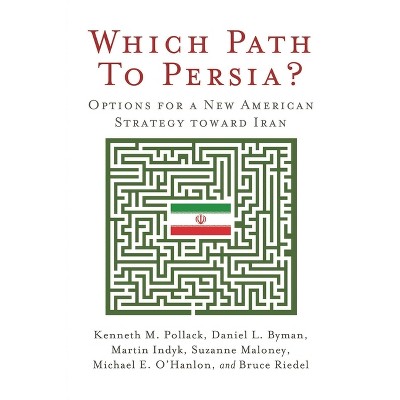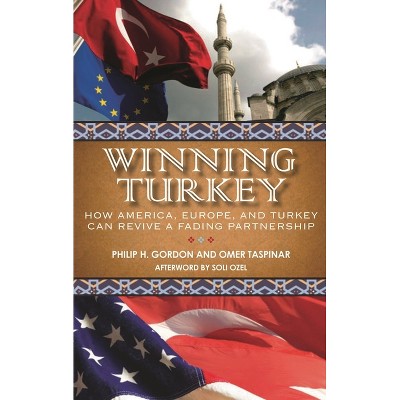Force without War - by Barry Blechman & Stephen S Kaplan (Paperback)

$35.00 when purchased online
Target Online store #3991
About this item
Highlights
- The United States has used military force short of war as an instrument of diplomacy on many occasions and in many areas of the world in the years since the Second World War.
- Author(s): Barry Blechman & Stephen S Kaplan
- 604 Pages
- Political Science, International Relations
Description
About the Book
The United States has used military force short of war as an instrument of diplomacy on many occasions and in many areas of the world in the years since the Second World War. This book describes and analyzes the circumstances accompanying 215 shows of force and examines how effective these actions were in helping to attain U.S. foreign policy objectives. Which type of force (air, ground, naval) was most often used? What did the forces do and how effective were they? Of what significance was Soviet involvement when U.S. military power was called upon to influence events? Was the threat presented by the alerting or deployment of strategic nuclear forces or by very large conventional forces especially telling? How clear is it that a desired effect was in fact caused by the demonstration of force? Barry Blechman and Stephen Kaplan explore these and other questions, examining also such elements as a President's domestic popularity and personal diplomacy preceding or during crises that led to U.S. military demonstrations. Complementing their analysis are five sets of case studies describing ten instances of the use of American military power to influence events in Central and Eastern Europe, the Middle East, South and Southeast Asia, and the Caribbean. The case studies--by David K. Hall, William B. Quandt, Jerome N. Slater, Robert M. Slusser, and Philip Windsor--focus on the reasons for U.S. action and the methods adopted, on the behavior of other parties, and on the relation between the use of force and the resolution of the crisis. The book's main conclusion is that the demonstrative use of U.S. armed forces has often stabilized a deteriorating situation enough to avoid further deterioration, relieved domestic and international pressure for more drastic and possibly self-defeating action, and gained time for diplomacy to achieve a more lasting remedy.Book Synopsis
The United States has used military force short of war as an instrument of diplomacy on many occasions and in many areas of the world in the years since the Second World War. This book describes and analyzes the circumstances accompanying 215 shows of force and examines how effective these actions were in helping to attain U.S. foreign policy objectives. Which type of force (air, ground, naval) was most often used? What did the forces do and how effective were they? Of what significance was Soviet involvement when U.S. military power was called upon to influence events? Was the threat presented by the alerting or deployment of strategic nuclear forces or by very large conventional forces especially telling? How clear is it that a desired effect was in fact caused by the demonstration of force? Barry Blechman and Stephen Kaplan explore these and other questions, examining also such elements as a President's domestic popularity and personal diplomacy preceding or during crises that led to U.S. military demonstrations. Complementing their analysis are five sets of case studies describing ten instances of the use of American military power to influence events in Central and Eastern Europe, the Middle East, South and Southeast Asia, and the Caribbean. The case studies--by David K. Hall, William B. Quandt, Jerome N. Slater, Robert M. Slusser, and Philip Windsor--focus on the reasons for U.S. action and the methods adopted, on the behavior of other parties, and on the relation between the use of force and the resolution of the crisis. The book's main conclusion is that the demonstrative use of U.S. armed forces has often stabilized a deteriorating situation enough to avoid further deterioration, relieved domestic and international pressure for more drastic and possibly self-defeating action, and gained time for diplomacy to achieve a more lasting remedy.Dimensions (Overall): 9.0 Inches (H) x 6.0 Inches (W) x 1.34 Inches (D)
Weight: 1.93 Pounds
Suggested Age: 22 Years and Up
Number of Pages: 604
Genre: Political Science
Sub-Genre: International Relations
Publisher: Brookings Institution Press
Theme: Diplomacy
Format: Paperback
Author: Barry Blechman & Stephen S Kaplan
Language: English
Street Date: December 1, 1978
TCIN: 1004111148
UPC: 9780815709855
Item Number (DPCI): 247-22-6044
Origin: Made in the USA or Imported
If the item details above aren’t accurate or complete, we want to know about it.
Shipping details
Estimated ship dimensions: 1.34 inches length x 6 inches width x 9 inches height
Estimated ship weight: 1.93 pounds
We regret that this item cannot be shipped to PO Boxes.
This item cannot be shipped to the following locations: American Samoa (see also separate entry under AS), Guam (see also separate entry under GU), Northern Mariana Islands, Puerto Rico (see also separate entry under PR), United States Minor Outlying Islands, Virgin Islands, U.S., APO/FPO
Return details
This item can be returned to any Target store or Target.com.
This item must be returned within 90 days of the date it was purchased in store, shipped, delivered by a Shipt shopper, or made ready for pickup.
See the return policy for complete information.











